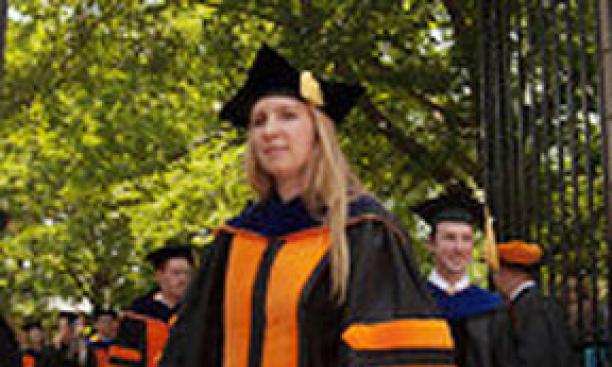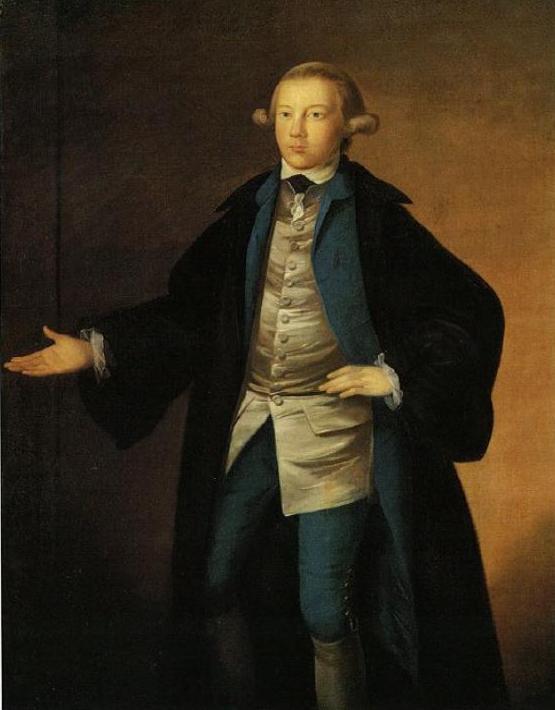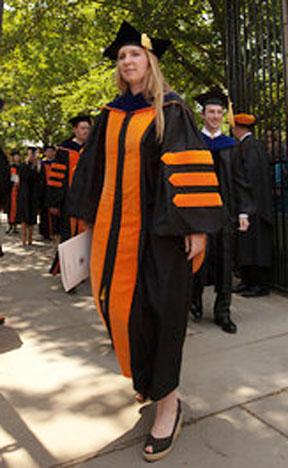


Nearly every college in the country pays silent tribute to Princeton at least once a year.
It’s time for Old Nassau to step up and take some credit.
Whenever proud college graduates parade in medieval-looking caps and gowns, they owe an unacknowledged debt to Princeton. Commencement programs typically invoke images of monastic robes and Oxford dons in their thumbnail histories of academic dress. But the nearly universally adopted design for academic regalia in American universities can be traced directly to Nassau Hall. It is time to set the record straight, especially since long-winded commencement speeches – many of which might as well be in Latin – make graduation programs some of the most thoroughly read documents in the land.
Caps and gowns came and went throughout the early years of American academic history. In the 1750s, Princeton started to require students to wear gowns, but a few years later, the trustees freed them from appearing in what they referred to as “peculiar habits.” The gowns re-appeared now and then, as we can see in a portrait of a member of the Class of 1773 in his academic finery, but overall their popularity waned until the end of the nineteenth century when they became something of a student fad. At that time, Princetonians were donning gowns for special events, students on other campuses began to call for them at commencement ceremonies, and Yale seniors were robed throughout their entire final semester.
This was an era that prized order and structure, even in higher education, where many of today’s familiar academic departments and learned societies were being created. And yet no one had thought to standardize academic dress, leading to motley commencement displays that one regalia historian has called confusing and bizarre. Princeton, in the nation’s service and in the service of all universities, would step forward to bring order to this collegiate costuming chaos.
Princeton trustee John J. McCook, a prominent New York lawyer and one of 15 “fighting McCooks” who had served as Civil War officers, chaired the board’s formal Committee on Academic Costumes in 1893. He was asked by the board to gather representatives of other leading American universities to adopt “a uniform academic costume.” The result was an intercollegiate commission, formed “on the initiative of Princeton University,” in the words of its chair, Columbia president Seth Low. This commission created a code for academic dress that has been used at colleges and universities throughout the country ever since. The code called for the now-familiar black gowns and mortarboard hats, which would be accompanied by hoods lined with each university’s distinctive color scheme and edged with a code-specified color signaling the field of study – white for arts, yellow for science, blue for philosophy, and so on.
One of the first major public displays of the code’s academic dress was at Princeton’s grand sesquicentennial celebration in 1896. To be properly outfitted for the event, faculty members had to buy the newly designated cap, gown, and hood, which cost nearly a week’s pay. The Sesquicentennial Memorial Book, in describing a parade of dignitaries stretching several hundred yards, records “a mass of brilliant color” with “the orange and black hoods of Princeton of course predominating.” It was, in the words of historian James Axtell, “the most impressive academic celebration in American history.”
Since this enduring contribution to collegiate costuming can be traced directly to Princeton, why doesn’t even our own Commencement program say so? The short answer is that the history has been hijacked by the gown-makers.
A few months after Princeton’s call for an intercollegiate costuming commission, a young Williams grad working in his family’s dry goods business published an article in The University Magazine describing cap-and-gown use in various American colleges. The author, Gardner Cotrell Leonard, had outfitted his college classmates for their graduation, and, upon becoming a partner in the family business, he established a special department for manufacturing academic caps, gowns, and hoods. Before long, he became the technical advisor to McCook and his fellow members of the Intercollegiate Commission, where he prepared design samples and shared his research into European academic dress. Not surprisingly, when Princeton’s board instructed the faculty to buy the newly designed regalia, Leonar’s firm became the official “gown-makers approved by the trustees.”
Leonard’s firm was ultimately acquired by the E.R. Moore Co., a name that still resonates in regalia circles. In the 1930s, this company published an oft-reprinted pamphlet called “The Story of Caps and Gowns.” The booklet emphasized (and romanticized) the grand ecclesiastical and Oxbridge-inspired traditions behind modern academic costumes. It also awarded full credit to Leonard (and thus to the firm itself) for the American approach to regalia, thereby erasing Princeton’s vital role in assembling the cap and gown commission in the first place. The gown-makers instead claimed that the entire effort resulted from Leonard’s subsequent magazine article. This bit of mythology has been repeated on many campuses at graduation ceremonies, as commencement programs have borrowed liberally from the pamphlet to describe their academic pageantry. Even Princeton itself, rarely reticent about its manifold contributions to life and learning, has failed to acknowledge its own catalytic role. Until now.
Let the record show: All those who are bachelored, mastered, or doctored in code-compliant regalia each year should pay homage to Nassau Hall. And for all those who dare to spurn the code’s detailed mandates as to color, shape and size – well, they should thank us too, since we also were among the first to break from the Code when 19th century’s search for order gave way to the 1960s’ creative impulses.
The code’s gowns were long, black, and heavy. Dignity was the order of the day, and color appeared only on the hood, where a sharp-eyed observer could identify the wearer’s degree, field, and university by the length, trim, color, and design. But President Robert F. Goheen ’40 *48, after seeing Harvard and Yale opt to garb their Ph.D.s in gowns of crimson and blue, commissioned the University’s marshals to fashion “a distinctive Princeton attire that would be gayer, lighter, and more comfortable, and at the same time, less expensive.” The code’s basic black regalia would still be permitted, but an optional new Ph.D. gown would feature Princeton’s primary color.
From that point onward, no special code-breaking key would be needed to identify a Ph.D. from Old Nassau. The Princeton doctoral gown itself would remain black: an all-orange gown, much like the one worn today by the marshals, was deemed “too bold” by the President. But three orange bars on the sleeves, combined with orange panels in front, would be Princeton’s special marks of distinction. Thereafter, whether the occasion called for pomp and circumstance or punting and passing, Princeton’s Tigers would sport the orange and black.
Today, even though Princeton’s orange-accented Ph.D. gown has broken from the code, bachelor’s and master’s regalia continue to toe the line. The only splashes of color come from the hoods, which are lined with a field of orange in which there is a black chevron, and an edging of either white for arts or golden yellow for science. Master’s hoods are a bit longer, and their edging will vary in color – peacock blue for public affairs, or brown for architecture, for example. Ph.D.s can still opt for the code’s standard black-on-black gown if they prefer. And so, at graduation, brand-new doctors can be seen honoring both Princeton’s contributions to academic tradition and its creative leadership in charting new directions. Come to think of it, that’s not a bad optical allusion to the University’s complex role in modem society.
Princeton’s unsung contributions to commencements across the country may not be acknowledged, but Princetonians can justifiably take pride in them. So, the next time you attend a graduation ceremony for a friend or family member, take a look at the long line of distinguished faculty members decked out in the regalia that symbolizes years, perhaps decades, dedicated to learning. And think to yourself, “I know something they don’t know.”
Donald L. Drakeman *88 s*88 p’02 was a lecturer in the politics department for many years, and is now a fellow at the University of Cambridge. Based on the research described in this article, he was named a Fellow of the Burgon Society, an organization dedicated to the study of academic dress. PAW reviewed Drakeman’s recent book about the Constitution here.
